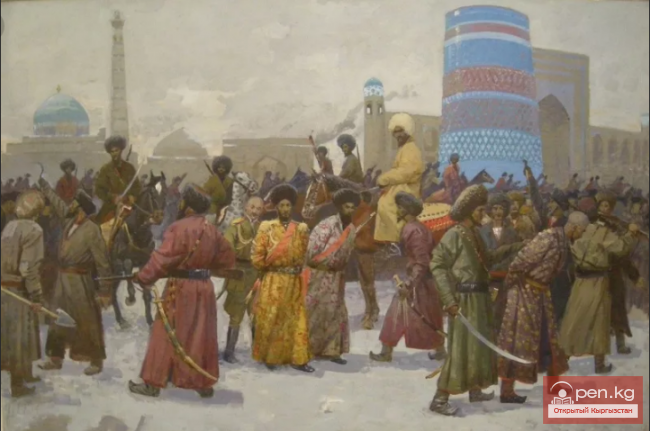
“THE KYRGYZ PUGACHEV”
Thus, since 1873, the struggle of the Kyrgyz people against the tyranny of Khudoyar Khan escalated into a real war, which did not cease until the Kokand ruler left the throne and fled under the protection of the imperial authorities. The reason for this fateful uprising of 1873 was the additional taxation imposed on the Kyrgyz of the southern regions of the Fergana Valley and Alai. It was prompted by a simple reason. In 1865, due to the actions of large Russian military forces, the territory of the Kokand Khanate was reduced to the size of the Fergana Valley plus the Kyrgyz pastures of Pamir-Alai.
The limitation of territory led to a reduction in revenue to the treasury, which prompted the khan to increase the amount of taxes and levies on the remaining population. A Russian political observer of that time, Yu. Rossel, wrote that the khan's officers began to impose additional taxes on the Kyrgyz, demanding three sheep from each yurt and a new land tax on cultivated land in the mountains. The Kyrgyz initially expressed their protest peacefully by refusing to pay the illegal and excessively high taxes. Then the khan's envoys began to "enlighten" the Kyrgyz using the usual means in such cases.
Outraged by the beatings and torture of innocent people, the Kyrgyz took up arms and engaged in battle with the khan's detachment. Subsequently, fearing the arrival of punitive forces, they left their places and migrated to remote mountain pastures. Other nomadic groups followed their example. According to sources, in 1873, a total of 20,000 Kyrgyz families and 10,000 Kipchaks, i.e., about 150,000 people, migrated to the mountainous areas. Many of them later joined the ranks of the rebels.
Thus began an unprecedented nationwide movement of the oppressed against the khan's tyranny. The leader of the rebels became a Kyrgyz from the Boston clan, Iskhak Khasan uulu, who took the name of one of the descendants of the ruling Ming dynasty - the grandson of Alim Khan named Pulat Khan, who was in seclusion.
The biography of this man, who was referred to at that time as the "Kyrgyz Pugachev," is quite interesting. Iskhak was born into the family of a Mardaris from Margilan around 1844. After studying for some time at a Kokand and then a Margilan madrasah, he dropped out in 1867 and settled among his tribesmen. He traveled extensively with the Kyrgyz and became well acquainted with their difficult, suffering life. Shortly before the uprising began, Iskhak took a job with an old associate of the court noble Alimkul - a small trader named Abdu-Mumin. It is known that a delegation of Kyrgyz, at the beginning of the uprising, went to Samarkand to the grandson of Alim Khan, Pulat, with a proposal to lead the rebels, but he refused to join the people. Then Iskhak declared himself Pulat. In the spring of 1873, in the Safid-Bulan area of the Aksy Valley, he was proclaimed khan - "raised on a white felt."
Soon, with a detachment of 200 supporters, he appeared in Chatkal. The self-proclaimed Pulat Khan led the popular movement against the Kokand khan. It should be noted that he was not the sole leader of the uprising but shared power with the leaders of individual rebel detachments, among whom the Andijan Kyrgyz Mamyr Mergenov and the Chatkal Kyrgyz Momun Shamurzakov were the most well-known.
It is quite characteristic that some Kyrgyz clan leaders, dissatisfied with Khudoyar, joined this popular movement to subtly impose their political plans on it.
The end of the life of the self-proclaimed "Pulat Khan" is known: on March 1, 1876, he was hanged in the market square in Margilan by order of the Russian authorities along with his comrade Akim-bek and some other leaders of the last popular uprising in the history of the Kokand Khanate.
Two years earlier, in the spring of 1874, part of the rebels led by Kyrgyz Mamyr appealed to the Governor-General of Turkestan with a request to accept them as Russian subjects. And on February 18, 1876, the territory of the Kokand Khanate was declared annexed to Russia by imperial manifesto and transformed into the Fergana region as part of the Turkestan Governor-Generalship. The first military governor of the new region was its conqueror M. D. Skobelev. Thus ended one of the darkest pages in the history of the Kyrgyz nation. Kurmandzhan Datka and her husband Alymbek were destined to play a significant role in the bloody drama at the end of the greatest Central Asian despotism of the 19th century. Subsequently, the Alai queen, after certain events, became one of the representatives of the local nobility of the Turkestan province of the Russian Empire. But that is already a new story...
The Time of Khudoyar Khan's Reign












































